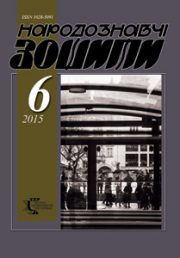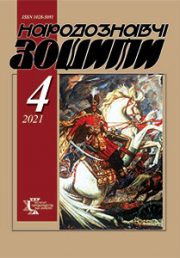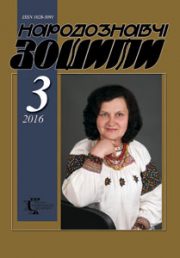The Ethnology Notebooks. 2021. № 4 (160), 947—952
UDK39(477) Шухевич:036(477.83-25) “18”
DOI https://doi.org/10.15407/nz2021.04.947
MOVNA Marianna
- ORCID ID http://orcid.org/0000-0003-2473-6998
- Ph. D. of Historical Sciences,
- Junior Researcher of the Vasyl Stefanyk
- National Scientific Library of Ukraine in Lviv
- National Academy of Sciences of Ukraine,
- Department of Scientific Bibliography,
- 2, Stefanyka str., 79000, Lviv, Ukraine,
- Contacts: e-mail: mari3anna@ukr.net
Abstract. On the occasion of such an important civilizational event in the economic and cultural life of Austria-Hungary in general and Lviv in particular, as the opening of the general regional Exhibition, which lasted from June 5 to November 16, 1894, the city received four guides. One of them is Volodymyr Shukhevych’s Ukrainian «Guidebook to regional exhibition in Lviv».
As the Ukrainian public also did not stay away from a significant event in the life of the city and region and jointly prepared its part of the exhibition, on the occasion of the opening of the regional Exhibition, the NTSh published the book «Guidebook to the Regional Exhibition» with the first integral Ukrainian-language block «Guidebook to Lviv».
The article for the first time reveals the role of V. Shukhevych as the author of the first integral Ukrainian-language block «Guidebook to Lviv» «Guidebook to the regional Exhibition in Lviv» (1894) and characterizes its content. It contains the first public view of Ukrainians on the Galician capital of the late nineteenth century: its historical destiny from the time of its foundation to the modern socio-cultural background in the Habsburg monarchy, a brief architectural and functional review of its most important historical monuments, practical advice on placing and filling the leisure of Ukrainian exhibitors and its guests. In order to solve specific research problems, a comparative, typological, method of historical reconstruction was used, and the methodology of biography was used.
Prospects for further studies of the chosen issues are to develop a little-known image of public figure and ethnographer V. Shukhevych as the author of the first Ukrainian-language guide information in Lviv and his popularization of the Ukrainian pavilion at the regional Exhibition in 1894 among the public.
Keywords: regional exhibition, Lviv, Ukrainian guidebook, V. Shukhevych, sights.
Received 3.08.2021
REFERENCES
- Моvna, М. (2013). Lviv guide-books (in the second half of the XIX-th — early XXI centuries): historico-bibliographical research. Lviv [in Ukrainian].
- Kovalchuk, M. (Ed.). (1894). An illustrated guide to Lviv and the Universal Regional Exhibition. Lviv [in Polish].
- (1894). Guidebook to the pavilion of the Lviv Ukrainian Folk Societies at the regional Exhibition. Uchytel’, 14/15, 233 [in Ukrainian].
- Levitsky, V. (1894). Literature. Zoria, 13, 308 [in Ukrainian].
- Shukhevich, V. (1894). Guidebook to the pavilion of the Lviv Ukrainian Folk Societies at the regional Exhibition. Lviv [in Ukrainian].
- Baranowski, B. (1894). A walk through the Regional Exhibition in 1894: a small guide to the Regional Exhibition. Lviv [in Polish].
- Arsenich, P. (1999). Volodymyr Shukhevich (1849—1915). Life and cultural, social and ethnographic activities: to the 150th anniversary of his birth. Ivano-Frankivsk: Nova Zoria [in Ukrainian].
- Shukhevich, V. (1902—1908). Hutsul region (Vol. 1—4). Lviv [in Polish].
- Shukhevich, V. (1899—1908). Hutsul region. Materials on Ukrainian ethnology (Part 1/5). Lviv [in Ukrainian].
- Shukhevich, V. (1894). Guidebook to Lviv. Guidebook to the play Regional in Lviv with special reference to the ethnographic department and the pavilion of Ukrainian folk societies (Pp. 31—66). Lviv [in Ukrainian].
- Shugurov, M. (1895). Bibliography (Vol. 50). Kievskaya Starina, 7/8, 38 [in Russian].






